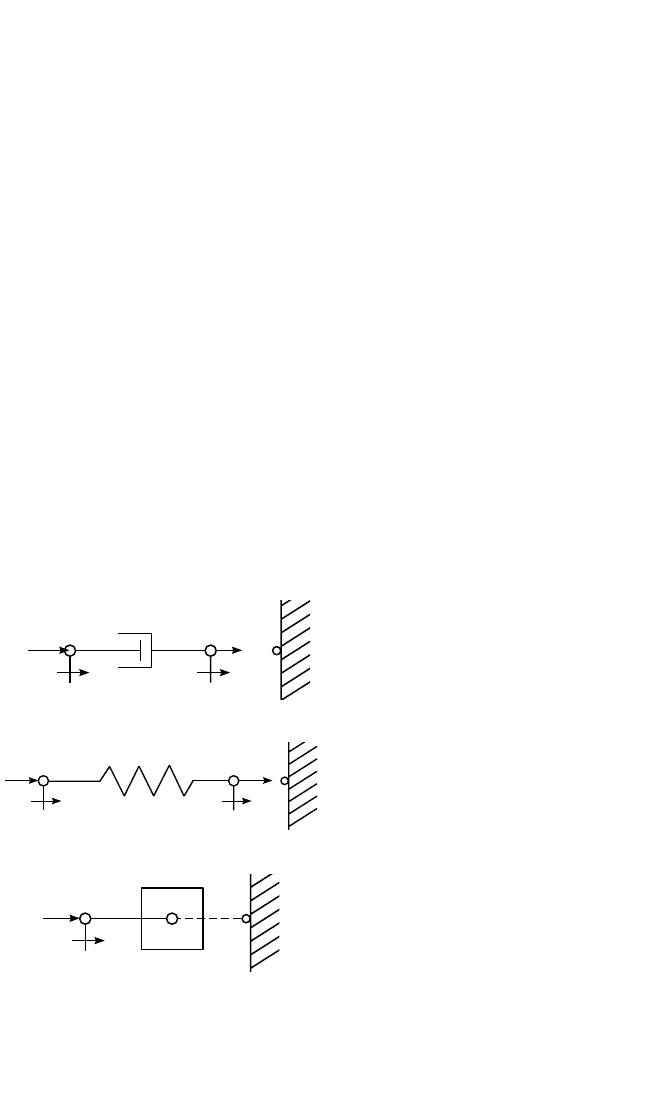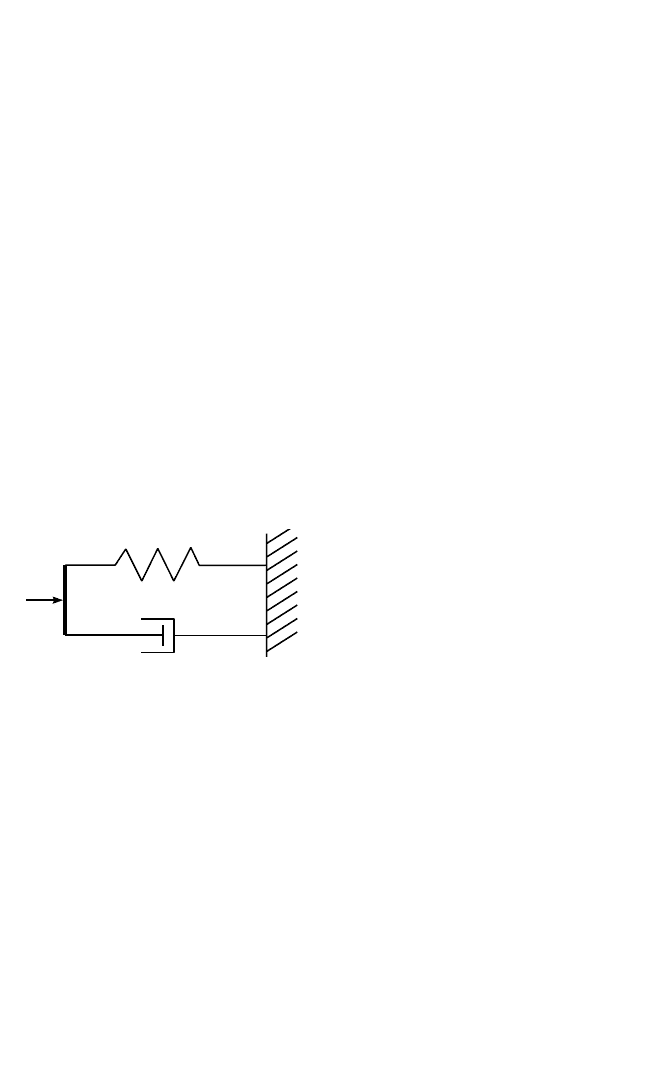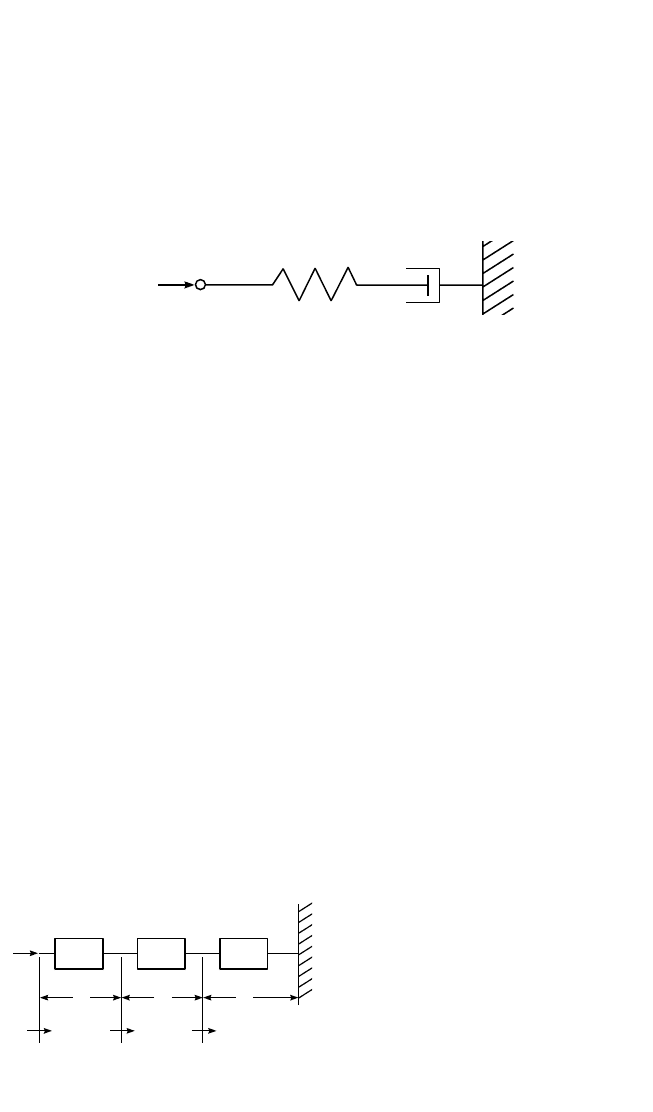Harris C.M., Piersol A.G. Harris Shock and vibration handbook
Подождите немного. Документ загружается.


CHAPTER 10
MECHANICAL IMPEDANCE
Elmer L. Hixson
INTRODUCTION
The mechanical impedance at a given point in a vibratory system is the ratio of the
sinusoidal force applied to the system at that point to the velocity at the same point.
For example, mechanical impedance is discussed in Chap. 6 as it relates to dynamic
absorbers and auxiliary mass dampers. In the following sections of this chapter, the
mechanical impedance of basic elements that make up vibratory systems is pre-
sented.This is followed by a discussion of combinations of these elements. Then, var-
ious mechanical circuit theorems are described. Such theorems can be used as an aid
in the modeling of mechanical circuits and in determining the response of vibratory
systems; they are the mechanical equivalents of well-known theorems employed in
the analysis of electric circuits. The measurement of mechanical impedance and
some applications are also given.
MECHANICAL IMPEDANCE OF VIBRATORY
SYSTEMS
The mechanical impedance Z of a system is the ratio of a sinusoidal driving force F
acting on the system to the resulting velocity v of the system. Its mechanical mobil-
ity is the reciprocal of the mechanical impedance.
Consider a sinusoidal driving F that has a magnitude F
0
and an angular fre-
quency ω:
F = F
0
e
jωt
(10.1)
The application of this force to a linear mechanical system results in a velocity ν:
ν = ν
0
e
j(ωt +φ)
(10.2)
where ν
0
is the magnitude of the velocity and φ is the phase angle between F and ν.
Then by definition, the mechanical impedance of the system Z (at the point of
application of the force) is given by
Z = F/ν (10.3)
10.1
8434_Harris_10_b.qxd 09/20/2001 11:18 AM Page 10.1

BASIC MECHANICAL ELEMENTS
The idealized mechanical systems considered in this chapter are considered to be
represented by combinations of basic mechanical elements assembled to form linear
mechanical systems. These basic elements are mechanical resistances (dampers),
springs, and masses. In general, the characteristics of real masses, springs, and
mechanical resistance elements differ from those of ideal elements in two respects:
1. A spring may have a nonlinear force-deflection characteristic; a mass may suffer
plastic deformation with motion; and the force presented by a resistance may not
be exactly proportional to velocity.
2. All materials have some mass; thus, a perfect spring or resistance cannot be
made. Some compliance or spring effect is inherent in all elements. Energy can
be dissipated in a system in several ways: friction, acoustic radiation, hysteresis,
etc. Such a loss can be represented as a resistive component of the element
impedance.
Mechanical Resistance (Damper). A mechanical resistance is a device in which
the relative velocity between the end points is proportional to the force applied to the
end points. Such a device can be represented by the dashpot of Fig. 10.1a, in which the
force resisting the extension (or compression) of the dashpot is the result of viscous
friction. An ideal resistance is assumed to be made of massless, infinitely rigid ele-
ments. The velocity of point A, v
1
, with respect to the velocity at point B, v
2
,is
v = (v
1
− v
2
) = (10.4)
where c is a constant of proportionality
called the mechanical resistance or
damping constant. For there to be a rel-
ative velocity v as a result of force at A,
there must be an equal reaction force at
B. Thus, the transmitted force F
b
is
equal to F
a
. The velocities v
1
and v
2
are
measured with respect to the stationary
reference G; their difference is the rela-
tive velocity v between the end points
of the resistance.
With the sinusoidal force of Eq. (10.1)
applied to point A with point B attached
to a fixed (immovable) point, the veloc-
ity v
1
is obtained from Eq. (10.4):
v
1
==v
0
e
jωt
(10.5)
Because c is a real number, the force
and velocity are said to be “in phase.”
The mechanical impedance of the
resistance is obtained by substituting
from Eqs. (10.1) and (10.5) in Eq. (10.3):
F
0
e
jωt
c
F
a
c
10.2 CHAPTER TEN
F
a
F
b
v
2
v
1
ABG
c
(a)
(c)
(b)
F
a
F
b
v
2
v
1
ABG
k
F
a
m
v
1
A
G
FIGURE 10.1 Schematic representations of
basic mechanical elements. (a) An ideal mechan-
ical resistance. (b) An ideal spring. (c) An ideal
mass.
8434_Harris_10_b.qxd 09/20/2001 11:18 AM Page 10.2

Z
c
==c (10.6)
The mechanical impedance of a resistance is the value of its damping constant c.
Spring. A linear spring is a device for which the relative displacement between its
end points is proportional to the force applied. It is illustrated in Fig. 10.1b and can
be represented mathematically as follows:
x
1
− x
2
= (10.7)
where x
1
, x
2
are displacements relative to the reference point G and k is the spring
stiffness. The stiffness k can be expressed alternately in terms of a compliance C =
1/k. The spring transmits the applied force, so that F
b
= F
a
.
With the force of Eq. (10.1) applied to point A and with point B fixed, the dis-
placement of point A is given by Eq. (10.7):
x
1
==x
0
e
jωt
The displacement is thus sinusoidal and in phase with the force.The relative velocity
of the end connections is required for impedance calculations and is given by the dif-
ferentiation of x with respect to time:
˙x = v ==F
0
e
j(ωt + 90°)
(10.8)
Substituting Eqs. (10.1) and (10.8) in Eq. (10.3), the impedance of the spring is
Z
k
=− (10.9)
Mass. In the ideal mass illustrated in Figs. 2.2 and 10.1c, the acceleration ¨x of the
rigid body is proportional to the applied force F:
¨x
1
= (10.10)
where m is the mass of the body. By Eq. (10.10), the force F
a
is required to give the
mass the acceleration ¨x
1
, and the force F
b
is transmitted to the reference G. When a
sinusoidal force is applied, Eq. (10.10) becomes
¨x
1
= (10.11)
The acceleration is sinusoidal and in phase with the applied force.
Integrating Eq. (10.11) to find velocity,
˙x = v =
F
0
e
jωt
jωm
F
0
e
jωt
m
F
a
m
jk
ω
ω
k
jωF
0
e
jωt
k
F
0
e
jωt
k
F
a
k
F
v
MECHANICAL IMPEDANCE 10.3
8434_Harris_10_b.qxd 09/20/2001 11:18 AM Page 10.3

The mechanical impedance of the mass is the ratio of F to v, so that
Z
m
==jωm (10.12)
Thus, the impedance of a mass is an imaginary quantity that depends on the magni-
tude of the mass and on the frequency.
COMBINATIONS OF MECHANICAL ELEMENTS
In analyzing the properties of mechanical systems, it is often advantageous to com-
bine groups of basic mechanical elements into single impedances. Methods for cal-
culating the impedances of such combined elements are described in this section.An
extensive coverage of mechanical impedance theory and a table of combined ele-
ments is given in Ref. 1.
Parallel Elements. Consider the combination of elements shown in Fig. 10.2, a
spring and a mechanical resistance. They are said to be in parallel since the same
force is applied to both, and both are constrained to have the same relative veloci-
ties between their connections.The force F
c
required to give the resistance the veloc-
ity v is found from Eqs. (10.3) and (10.6).
F
c
= vZ
c
= vc
The force required to give the spring this
same velocity is, from Eqs. (10.8) and
(10.9),
F
k
= vZ
k
=
The total force F is
F = F
c
+ F
k
Since Z = F/v,
Z = c − j
Thus, the total mechanical impedance is the sum of the impedances of the two ele-
ments.
By extending this concept to any number of parallel elements, the driving force F
equals the sum of the resisting forces:
F =
n
i = 1
vZ
i
= v
n
i = 1
Z
i
and Z
p
=
n
i = 1
Z
i
(10.13)
where Z
p
is the total mechanical impedance of the parallel combination of the indi-
vidual elements Z
i
.
Since mobility is the reciprocal of impedance, when the properties of the parallel
elements are expressed as mobilities, the total mobility of the combination follows
from Eq. (10.13):
k
ω
vk
jω
F
0
e
jωt
F
0
e
jωt
/jωm
10.4 CHAPTER TEN
c
F
AB
k
FIGURE 10.2 Schematic representation of a
parallel spring-resistance combination.
8434_Harris_10_b.qxd 09/20/2001 11:18 AM Page 10.4

=
n
i = 1
(10.14)
Series Elements. In Fig. 10.3 a spring and damper are connected so that the
applied force passes through both elements to the inertial reference. Then the veloc-
ity v is the sum of v
k
and v
c
. This is a series combination of elements. The method for
determining the mechanical impedance of the combination follows.
Consider the more general case of three arbitrary impedances shown in Fig. 10.4.
Determine the impedance presented by the end of a number of series-connected
elements. Elements Z
1
and Z
2
must have no mass, since a mass always has one end
connected to a stationary inertial reference. However, the impedance Z
3
may be a
mass. The relative velocities between the end connections of each element are indi-
cated by v
a
, v
b
, and v
c
; the velocities of the connections with respect to the stationary
reference point G are indicated by v
1
, v
2
, and v
3
:
v
3
= v
c
v
2
= v
3
+ (v
2
− v
3
) = v
c
+ v
b
v
1
= v
2
+ (v
1
− v
2
) = v
a
+ v
b
+ v
c
The impedance at point 1 is F/v
1
, and the force F is transmitted to all three elements.
The relative velocities are
v
a
= v
b
= v
c
=
Thus, the total impedance is defined by
= =++
Extending this principle to any number of massless series elements,
=
n
i = 1
(10.15)
where Z
s
is the total mechanical imped-
ance of the elements Z
i
connected in
series.
Since mobility is the reciprocal of
impedance, the total mobility of series
connected elements (expressed as mobil-
ities) is
1
Z
i
1
Z
s
1
Z
3
1
Z
2
1
Z
1
F/Z
1
+ F/Z
2
+ F/Z
3
F
1
Z
F
Z
3
F
Z
2
F
Z
1
1
i
1
p
MECHANICAL IMPEDANCE 10.5
c
F
k
FIGURE 10.3 Schematic representation of a series com-
bination of a spring and a damper.
1
F
23G
Z
1
Z
2
v
1
Z
3
v
a
v
b
v
c
v
2
v
3
FIGURE 10.4 Generalized three-element sys-
tem of series-connected mechanical impedances.
8434_Harris_10_b.qxd 09/20/2001 11:18 AM Page 10.5

s
=
n
i = 1
i
(10.16)
Using Eqs. (10.15) and (10.16), the mobility and impedance for Fig. 10.3 become:
= 1/c + jω/k and Z = (ck/jω)/(c + k/jω)
MECHANICAL CIRCUIT THEOREMS
The following theorems are the mechanical analogs of theorems widely used in ana-
lyzing electric circuits. They are statements of basic principles (or combinations of
them) that apply to elements of mechanical systems. In all but Kirchhoff’s laws, these
theorems apply only to systems composed of linear, bilateral elements. A linear ele-
ment is one in which the magnitudes of the basic elements (c, k, and m) are constant,
regardless of the amplitude of motion of the system; a bilateral element is one in
which forces are transmitted equally well in either direction through its connections.
KIRCHHOFF’S LAWS
1. The sum of all the forces acting at a point (common connection of several ele-
ments) is zero:
n
i
F
i
= 0 (at a point) (10.17)
This follows directly from the considerations leading to Eq. (10.13).
2. The sum of the relative velocities across the connections of series mechanical ele-
ments taken around a closed loop is zero:
n
i
v
i
= 0 (around a closed loop) (10.18)
This follows from the considerations leading to Eq. (10.14).
Kirchhoff’s laws apply to any system, even when the elements are not linear or
bilateral.
Example 10.1. Find the velocity of all the connection points and the forces act-
ing on the elements of the system shown in Fig. 10.5. The system contains two veloc-
ity generators v
1
and v
6
.Their magnitudes are known, their frequencies are the same,
and they are 180° out-of-phase.
A. Using Eq. (10.17), write a force equation for each connection point except
a and e.
At point b: F
1
− F
2
− F
3
= 0. In terms of velocities and impedances:
(v
1
− v
2
)Z
1
− (v
2
− v
3
)Z
2
− (v
2
− v
4
)Z
4
= 0(a)
At point c, the two series elements have the same force acting: F
2
− F
2
= 0. In terms
of velocities and impedances:
(v
2
− v
3
)Z
2
− (v
3
− v
4
)Z
3
= 0(b)
At point d: F
2
+ F
3
− F
4
− F
5
= 0. In terms of velocities and impedances:
10.6 CHAPTER TEN
8434_Harris_10_b.qxd 09/20/2001 11:18 AM Page 10.6

(v
3
− v
4
)Z
3
+ (v
2
− v
4
)Z
4
− (v
4
+ v
6
)Z
5
− (v
4
− v
5
)Z
6
= 0(c)
Note that v
6
is (+) because of the 180° phase relation to v
1
.
At point f: F
5
− F
5
= 0. In terms of velocities and impedances:
(v
4
− v
5
)Z
6
− v
5
Z
7
= 0(d)
Since v
1
and v
6
are known, the four unknown velocities v
2
, v
3
, v
4
, and v
5
may be deter-
mined by solving the four simultaneous equations above. After the velocities are
obtained, the forces may be determined from the following:
F
1
= (v
1
− v
2
)Z
1
F
2
= (v
2
− v
3
)Z
2
= (v
3
− v
4
)Z
3
F
3
= (v
2
− v
4
)Z
4
F
4
= (v
4
+ v
6
)Z
5
F
5
= (v
4
− v
5
)Z
6
= v
5
Z
7
B. The method of node forces. Equations (a) through (d) above can be rewritten
as follows:
v
1
Z
1
= (Z
1
+ Z
2
+ Z
3
)v
2
− Z
2
v
3
− Z
4
v
4
(a′ )
0 =−Z
2
v
2
+ (Z
2
+ Z
3
)v
3
− Z
3
v
4
(b′ )
0 =−Z
4
v
2
− Z
3
v
3
+ (Z
3
+ Z
4
+ Z
5
+ Z
6
)v
4
− Z
6
v
5
(c′ )
−v
6
Z
5
=−Z
6
v
4
+ (Z
6
+ Z
7
)v
5
(d′ )
These equations can be written by inspection of the schematic diagram by the follow-
ing rule: At each point with a common velocity (force node), equate the force generators
to the sum of the impedances attached to the node multiplied by the velocity of the node,
minus the impedances multiplied by the velocities of their other connection points.
When the equations are written so that the unknown velocities form columns, the
equations are in the proper form for a determinant solution for any of the
unknowns. Note that the determinant of the Z’s is symmetrical about the main diag-
onal. This condition always exists and provides a check for the correctness of the
equations.
C. Using Eq. (10.18), write a velocity equation in terms of force and mobility
around enough closed loops to include each element at least once. In Fig. 10.5, note
that
F
3
= F
1
− F
2
and F
5
= F
1
− F
4
MECHANICAL IMPEDANCE 10.7
Z
5
e
f
(2) G
Z
6
F
5
F
4
Z
7
v
5
v
6
Z
2
Z
1
c
(1)
Z
4
F
3
v
2
v
1
v
3
v
4
F
2
F
1
b
d
a
A
Z
3
FIGURE 10.5 System of mechanical elements and vibration sources analyzed in Example 10.1 to
find the velocity of each connection and the force acting on each element.
8434_Harris_10_b.qxd 09/20/2001 11:18 AM Page 10.7

Around loop (1):
F
2
(
2
+
3
) − (F
1
− F
2
)
4
= 0(e)
The minus sign preceding the second term results from going across the element 4 in
a direction opposite to the assumed force acting on it.
Around loop (2):
F
4
5
− v
6
− (F
1
− F
4
)(
6
+
7
) = 0(f)
A summation of velocities from A to G along the upper path forms the following
closed loop:
v
1
+ F
1
1
+ F
2
(
2
+
3
) + F
4
5
− v
6
= 0(g)
Equations (e), (f ), and (g) then may be solved for the unknown forces F
1
, F
2
, and F
4
.
The other forces are F
3
= F
1
− F
2
and F
5
= F
1
− F
4
. The velocities are:
v
2
= v
1
− F
1
1
v
3
= v
2
− F
2
2
v
4
= v
2
− F
3
4
v
5
= F
5
7
When a system includes more than one source of vibration energy, a Kirchhoff’s
law analysis with impedance methods can be made only if all the sources are oper-
ating at the same frequency. This is the case because sinusoidal forces and velocities
can add as phasors only when their frequencies are identical. However, they may dif-
fer in magnitude and phase. Kirchhoff’s laws still hold for instantaneous values and
can be used to write the differential equations of motion for any system.
RECIPROCITY THEOREM
If a force generator operating at a particular frequency at some point (1) in a system
of linear bilateral elements produces a velocity at another point (2), the generator can
be removed from (1) and placed at (2); then the former velocity at (2) will exist at (1),
provided the impedances at all points in the system are unchanged. This theorem also
can be stated in terms of a vibration generator that produces a certain velocity at its
point of attachment (1), regardless of force required, and the force resulting on some
element at (2).
Reciprocity is an important characteristic of linear bilateral elements. It indicates
that a system of such elements can transmit energy equally well in both directions. It
further simplifies the calculation on two-way energy transmission systems since the
characteristics need be calculated for only one direction.
SUPERPOSITION THEOREM
If a mechanical system of linear bilateral elements includes more than one vibration
source, the force or velocity response at a point in the system can be determined by
adding the response to each source, taken one at a time (the other sources supplying
no energy but replaced by their internal impedances).
The internal impedance of a vibrational generator is that impedance presented at
its connection point when the generator is supplying no energy. This theorem finds
useful application in systems having several sources. A very important application
arises when the applied force is nonsinusoidal but can be represented by a Fourier
10.8 CHAPTER TEN
8434_Harris_10_b.qxd 09/20/2001 11:18 AM Page 10.8

series. Each term in the series can be considered a separate sinusoidal generator.The
response at any point in the system can be calculated for each generator by using the
impedance values at that frequency. Each response term becomes a term in the
Fourier series representation of the total response function.The over-all response as
a function of time then can be synthesized from the series.
Figure 10.6 illustrates an application of superposition. The velocities v
c
′ and v
c
″
can be determined by the methods of Example 10.1. Then the velocity v
c
is the sum
of v
c
′ and v
c
″.
THÉVENIN’S EQUIVALENT SYSTEM
If a mechanical system of linear bilateral elements contains vibration sources and
produces an output to a load at some point at any particular frequency, the whole sys-
tem can be represented at that frequency by a single constant-force generator F
c
in par-
allel with a single impedance Z
i
connected to the load. Thévenin’s equivalent-system
representation for a physical system may be determined by the following experi-
mental procedure: Denote by F
c
the force which is transmitted by the attachment
point of the system to an infinitely rigid fixed point; this is called the clamped force.
When the load connection is disconnected and perfectly free to move, a free veloc-
ity v
f
is measured.Then the parallel impedance Z
i
is F
c
/v
f
.The impedance Z
i
also can
be determined by measuring the internal impedance of the system when no source
is supplying motional energy.
If the values of all the system ele-
ments in terms of ideal elements are
known, F
c
and Z
i
may be determined
analytically. A great advantage is de-
rived from this representation in that
attention is focused on the characteris-
tics of a system at its output point and
not on the details of the elements of the
system.This allows an easy prediction of
the response when different loads are
attached to the output connection.After
a final load condition has been deter-
mined, the system may be analyzed in
detail for strength considerations.
NORTON’S EQUIVALENT
SYSTEM
A mechanical system of linear bilateral
elements having vibration sources and
an output connection may be represented
at any particular frequency by a single
constant-velocity generator v
f
in series
with an internal impedance Z
i
.
This is the series system counterpart
of Thévenin’s equivalent system where
v
f
is the free velocity and Z
i
is the
impedance as defined above. The same
MECHANICAL IMPEDANCE 10.9
c
F
1
v
c
Z
1
Z
3
Z
2
(a)
F
2
c
F
1
v
c
'
Z
1
Z
3
Z
2
(b)
c
v
c
"
Z
1
Z
3
Z
2
(c)
F
2
FIGURE 10.6 System of mechanical elements
including two force generators used to illustrate
the principle of superposition.
8434_Harris_10_b.qxd 09/20/2001 11:18 AM Page 10.9

advantages in analysis exist as with Thévenin’s parallel representation. The most
advantageous one depends upon the type of structure to be analyzed. In the experi-
mental determination of an equivalent system, it is usually easier to measure the free
velocity than the clamped force on large heavy structures, while the converse is true
for light structures. In any case, one representation is easily derived from the other.
When v
f
and Z
i
are determined, F
c
= v
f
Z
i
.
MECHANICAL 2-PORTS
Consider the “black box” shown in Fig. 10.7. It may have many elements between
terminals (ports) (1) and (2). The forces and velocities at the ports can be deter-
mined by the use of 2-port equations in terms of impedances and mobilities. The
impedance parameter equations are
F
1
= Z
11
v
1
+ Z
12
v
2
and F
2
= Z
21
v
1
+ Z
22
v
2
The Z parameters can be determined by measurements or from a known circuit
model. These parameters are defined as follows:
1. For v
2
= 0 (port 2 clamped), Z
11
= F
1
/v
1
and Z
21
= F
2
/v
1
.
2. For v
1
= 0 (port 1 clamped), Z
12
= F
1
/v
2
and Z
22
= F
2
/v
2
The mobility parameter equations for this situation are as follows:
v
1
=
11
F
1
+
12
F
2
and v
2
=
12
F
1
+
22
F
2
These parameters can be determined by measurement or from a model. The def-
initions are as follows:
1. For F
2
= 0 (port 2 free),
11
= v
1
/F
1
and
12
= v
2
/F
1
.
2. For F
1
= 0 (port 1 free),
21
= v
1
/F
2
and
22
= v
2
/F
2
.
Note that for large, massive structures, it may be difficult to clamp the ports to meas-
ure the impedance parameters. In this case, the mobility parameters requiring free
conditions may be more appropriate. Likewise, for very light structures, the imped-
ance parameters may be more appropriate. In any case, one set of parameters can be
determined from the other by matrix inversion.
10.10 CHAPTER TEN
BLACK
BOX
F
2
F
1
(1) (2)
v
1
v
2
FIGURE 10.7 “Black box” representation of a me-
chanical system.
8434_Harris_10_b.qxd 09/20/2001 11:18 AM Page 10.10
